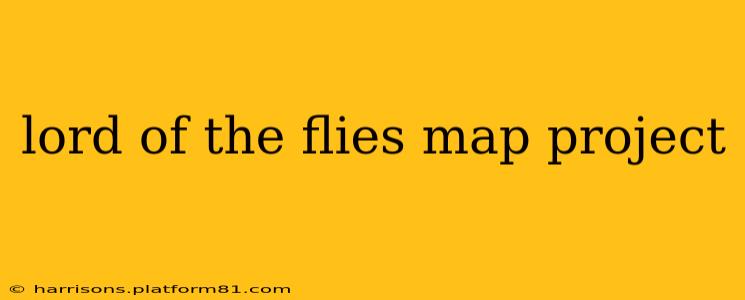The island in William Golding's Lord of the Flies is more than just a setting; it's a character in itself, reflecting the boys' descent into savagery. A map project exploring this crucial element offers a fantastic opportunity to delve deeper into the novel's themes and symbolism. This guide provides a comprehensive approach to creating a compelling and insightful Lord of the Flies map project, addressing common questions and offering creative ideas.
What are the key features of the island in Lord of the Flies?
The island in Lord of the Flies is described with specific features that are crucial to understanding the story's events and symbolism. These include:
- The Beach: The initial landing site, representing civilization and hope. It's where the boys initially attempt to establish order and rescue.
- The Mountain (Castle Rock): A symbol of power and dominance. Ralph's conch shell loses its authority as the boys ascend this peak, signifying the decline of order. It's also the location of Jack's savage tribe and the ultimate symbol of their primal instincts.
- The Forest: A mysterious and unpredictable area, often associated with fear and the unknown. It's where Simon encounters the Lord of the Flies and Piggy is murdered. The forest's dense nature mirrors the boys' descent into chaos.
- The Lagoon: A source of fresh water and food, representing a potential lifeline. The lagoon contrasts with the more dangerous and wild aspects of the island.
- The "Lord of the Flies" location: The specific location of the pig's head impaled on a stick is often debated, but its placement within the forest highlights the power of primal fear and the darkness within human nature.
What are some ideas for a Lord of the Flies map project?
There are several ways to approach a Lord of the Flies map project, each offering unique opportunities for analysis and creativity:
-
A Traditional Map: Create a detailed map of the island, marking key locations mentioned in the novel. Include labels and descriptions for each area, highlighting their significance to the plot. This allows for a visual representation of the island's layout and the events unfolding across its terrain.
-
A Thematic Map: Focus on specific themes, such as civilization vs. savagery, or the boys' transformation. Different areas could be color-coded or symbolized to represent these themes, offering a visual interpretation of the novel’s central conflicts.
-
A 3D Model: Create a three-dimensional model of the island, incorporating physical features and key locations. This project offers a more tangible and immersive approach, allowing for a deeper engagement with the novel's setting.
-
An Interactive Map: Use digital tools to create an interactive map. Include clickable points that reveal descriptions, images, and quotes from the book related to each location. This adds a technological dimension to the project, enhancing its interactivity and engagement.
How can I create a visually appealing Lord of the Flies map?
The visual appeal of your map is crucial. Consider these aspects:
-
Color Scheme: Use colors that evoke the moods and themes of the novel. For example, muted greens and browns for the forest, and brighter colors for the beach.
-
Symbols: Develop a consistent set of symbols to represent key locations and events. This adds visual clarity and consistency to your map.
-
Scale: Maintain a consistent scale to accurately represent distances and proportions on the island.
-
Legend: Include a clear legend to explain your symbols and color-coding. This makes your map easy to understand and interpret.
What are some resources I can use for my Lord of the Flies map project?
While there isn't a single, definitive map of the island from the book itself, you can use the descriptions within the text to create your own interpretation. Remember to cite the novel's descriptions to support your map's layout and key feature placements.
The book itself is your primary resource, but you may find inspiration from illustrative materials related to Lord of the Flies available online. However, avoid direct copying—focus on interpreting the textual descriptions to build your own unique vision of the island.
By approaching your Lord of the Flies map project thoughtfully and creatively, you can create a powerful and insightful representation of this crucial element in Golding’s masterpiece. Remember that your map is an interpretation – let your creativity and understanding of the novel guide you.
